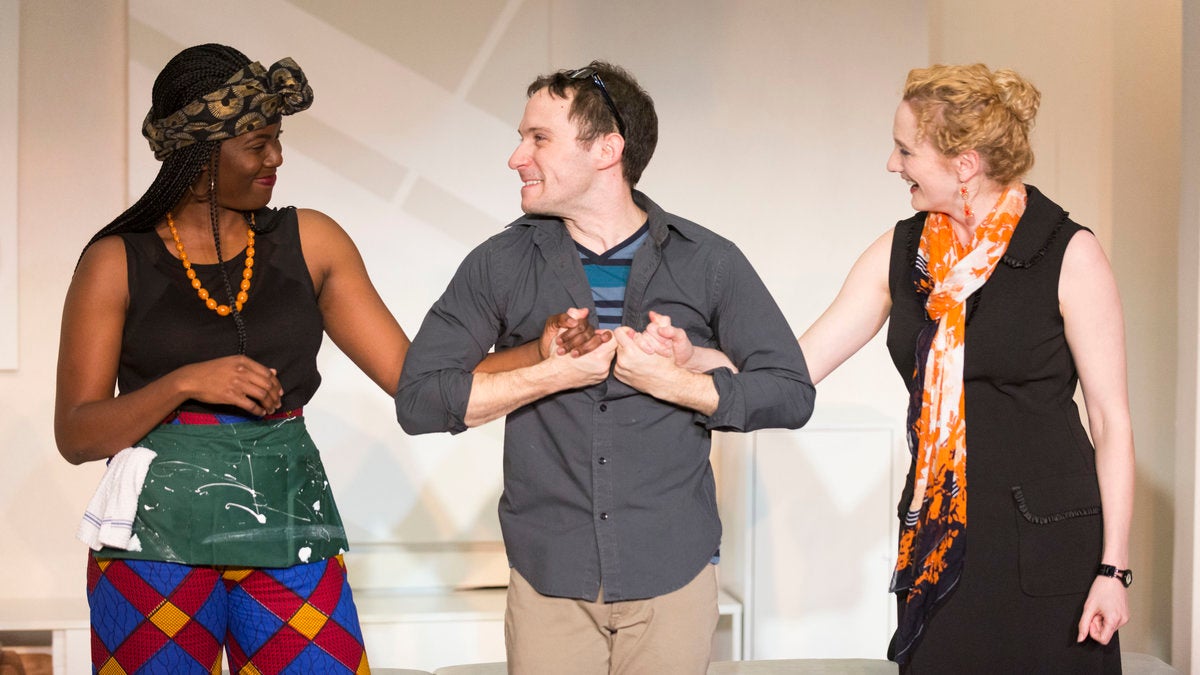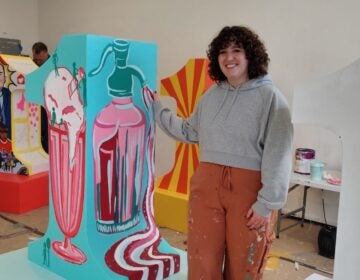Review: ‘White,’ or is it black?

In Theatre Horizon's production of 'White," from left: Jaylene Clark Owens, Jamison Foreman and Jessica Bedford. (Photo courtesy of Matthew J. Photography)
Long before “alternative facts” became a concept the White House employs, James Ijames began writing his play “White,” whose plot is driven by … can we just call them out-and-out lies? Ijames (pronounced EYE-ams) may not have known just how prescient he would be. His world premiere is striking a chord – the play’s run at Theatre Horizon in Norristown was supposed to be over this past weekend, but now begins its extended week.
Ijames, a theater artist who grew into his own by acting on Philadelphia stages, and then began writing for them, too, is clearly on to something with “White.” It refers to the sort of paintings produced by a young and successful artist who uses white space in them to represent various parts of himself. “White” also refers to the artist, who is white, gay, and a pal of the woman curating a prestigious modern-art show he wants desperately to be part of.
That’s out of the question. The insufferably self-involved curator sees her new show as a way of presenting outré art – or maybe any art – by young or newly discovered artists. If they are anything but white and male, they are the curator’s Holy Grail.
The curator (Jessica Bedford) minces no words when Gus, the artist (Jamison Foreman) asks her point blank to be in her show. She wants art that “truly represents America” and “you are exactly what I’m not looking for – white dudes!” she tells him. She adds, possibly only to soften the blow, that the work he does would be perfect … “if you were black and female.”
So Gus takes her up on it. Gus approaches his boyfriend (Justin Jain) to put him in touch with a black actress (Jaylene Clark Owens) the boyfriend’s been working with at an improv class. Gus will create the paintings. She’ll be known as the artist. “Don’t you want people to recognize you for what you created?” his boyfriend asks. “It’s an act of absence,” he answers, a phrase that may come from the same linguistic netherworld as “alternative facts.” (Which does not show up in Ijames’ script. It doesn’t need to.)
“White,” a meaty play, addresses many issues: How we perceive any art differently once we know the background of the person who created it; they way we may depend on gatekeepers to tell us what’s current or chic; how, in efforts to be diverse, we treat those who are not. About that first part – knowing the background of the creator – Ijames is an African American man, and there’s an honesty about his play that considers both Gus’ argument and the curator’s.
Aside from the curator’s misguided image of her own impact, her points about overlooked artists are well-taken. But so is Gus’ argument about merit for its own sake. Curiously, Ijames has written a play that speaks both for and against affirmative action. But what will grab you is how well it speaks as a portrait of conflict.
Under Malika Oyetimein’s direction, “White” plays out at as high energy – perhaps too high at times. I could never tell whether she was directing “White” as a play with characters or with caricatures, or whether Ijames had his own choice in the matter. If it’s characters they were looking for, the play is frequently and obviously over-acted; if it’s caricatures, the production is just right. After a while, I decided not to guess and to just follow the dialogue to see where Ijames would go with all this. He goes, it turns out, into exciting intellectual territory — another way of saying, for “White,” solid theater.–“White” is extended through at May 28 at Theatre Horizon, 401 DeKalb St., Norristown. 610-283-2230 or theatrehorizon.org.
WHYY is your source for fact-based, in-depth journalism and information. As a nonprofit organization, we rely on financial support from readers like you. Please give today.




